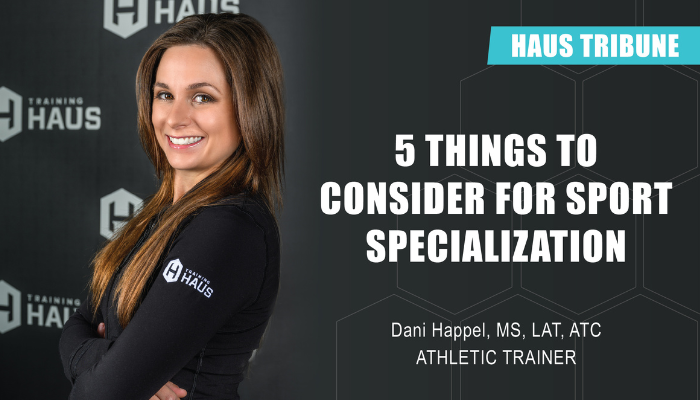
Sport Specialization: 5 Things to Consider
Both parents and athletes want to be successful in sports, and they may choose sport specialization to get ahead. However, this isn’t always the best course of action.
Currently, sport specialization is defined as intense, year-round training in a single sport at the exclusion of other sports. The threshold for early sport specialization has yet to be clearly defined, but any specialization under the age of 12 is considered early by the American Orthopedic Society for Sports Medicine. Sport specialization can favor technical sports with early peak times such as gymnastics, dance, and figure skating, but research shows it may not be beneficial for athletes in team sports.
Peer-reviewed studies measuring sport specialization during adolescence have been conducted at the Division I level. Currently, there is no evidence that D-1 student-athletes specialized in their sports earlier than other students not playing for their university’s athletics program.
Consequently, there are links between overuse injuries and the level of sport specialization. Meaning, the more specialized the athlete is in their respective sport, the higher the risk they are for a serious overuse injury. There are other negative consequences associated with sport specialization such as social isolation and burnout.
Five Recommendations for Sport Specialization
1. Make sure your athlete is taking breaks throughout the year.
If participating in sport-specific activities, athletes should take 2-3 months off per year. This does not have to be done all at once. Try to get at least one-month intervals throughout the year.
2. Keep training hours per week the same as the athlete’s age.
For example, a 14-year-old soccer player should be playing their sport only 14 hours per week. This guideline should allow the athlete to have some unorganized play time or free play that isn’t associated with organized sports. For every two hours of sport play, one hour of free play is recommended.
3. Make sure your athlete is taking breaks during the week.
It is recommended that the athlete take 1-2 days off per week from competition, practices, and sport-specific training to allow for adequate rest. This will provide time for the athlete’s body to adapt to the specific load and prevent any potential effects of overtraining.
4. Try sport sampling.
Give the athlete opportunities to participate in other sports and activities. This will allow the athlete to improve their general fitness and learn fundamental skills early on. Be careful of participating in similar sports that emphasize the same body part which could inadvertently lead to an overuse injury.
5. Wait until late adolescence to start specialization.
Late adolescence begins around the age of 16, according to the American Orthopedic Society of Sports Medicine. Delaying sport specialization to late adolescence can give the athlete time to physically develop and grow a social support system to handle the demands of year-round training in one sport.
If playing another sport isn’t an option, the weight room can be considered a secondary “sport” for athletes. Training HAUS offers sports performance training options such as small group training and junior development classes. Our junior development program gives young athletes the opportunity to develop general strength fundamentals, learn proper biomechanics in sports performance training, and prevent injuries.
REFERENCES
1. Systematic Review of Health Organization Guidelines Following the AMSSM 2019 Youth Early Sport Specialization Summit. Herman DC, et al. Sports Health. 2022;14(1):127-134.
2. National Athletic Trainers’ Association Position Statement: Prevention of Pediatric Overuse Injuries. Valovich McLeod VC, et al. Journal of Athletic Training. 2011;46(2):206-220.
3. Health Consequences of Youth Sport Specialization. Jayanthi NA, et al. Journal of Athletic Training. 2019;54(10)1040-1049.
4. Early Single Sport Specialization in a High-Achieving US Athlete Population: Comparing National Collegiate Athletic Association Student-Athletes and Undergraduate Students. DiFiori JP, et al. Journal of Athletic Training. 2019;54(10):1050-1054.
5. High School Sport Specialization Patterns of Current Division I Athletes. Post EG, et al. Sports Health. 2017;9(2):148-153.

